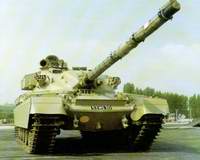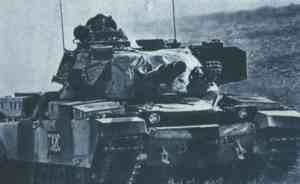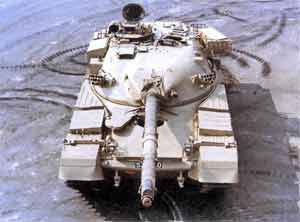| Designation: | Chieftain Mk5 |
 |
|---|---|---|
| Manufacturer: | Vickers Defence Systems Ltd. | |
| Product type: | Armoured Vehicles | |
| Name: | Main battle tank |
Mk 1 of which 40 were built and issued for training in 1965-66, 585 bhp engine.
Mk 1/2 is Mk 1 brought up to Mk 2 standard and used for training.
Mk 1/3 is Mk 1 with a new power pack and used for training.
Mk 1/4 is Mk 1 with a new power pack and modified RMG, used for training.
Mk 2 was the first model to enter service, first issued in 1967, with a 650 bhp engine.
Mk 3 entered service in 1969, has improved auxiliary generator, 650 bhp engine, dry-air cleaner element, modified No 15 Mk 2 cupola with L37A1 7.62 mm machine gun, oil-filled top rollers, axle arms and track tensioner.
Mk 3/G was a prototype only with turret air-breathing for engine aspiration. Mk 3/2 is Mk 3/G modified. Mk 3/S is production model of Mk 3/G with turret air-breathing and commander's firing switch. Mk 3/3 is Mk 3 with extended range RMG, fitted to accept the Pilkington Optronics laser rangefinder, modified 720 bhp engine, new low-loss air cleaner system, turret aspiration and modified NBC pack. Mk 3/3P is Mk 3/3 export version for Iran. Mk 4, of which only two were built, had increased fuel capacity and other minor modifications. Mk 5 is a development of the Mk 3/3 with uprated 720 bhp engine and strengthened gearbox, gunner's telescope and commander's collimator fitted with graticule for use with extended range 12.7 mm RMG ammunition, modified exhaust system, air cleaning filters for generator, battery heating and lagging, new type gun clamp to accept new thermal sleeve, modified charge bins, improved No 43 gunner's telescope mounting, improved stowage, 50 per cent reduction in RMG ammunition-carrying capacity, increase in APDS-T projectiles carried, No 37 Mk 4 commander's sight, stabilised infrared detector, commander's machine gun elevation to +90° and new NBC pack. Mk 5/2K is Mk 5 for Kuwait, produced by Royal Ordnance Leeds and Vickers at Elswick with final
vehicles completed late in 1979.
Mk 5/3P is a Mk 5 for Iranian Army.
Mk 6 is Mk 2 with a new power pack and modified RMG.
Mk 7 is Mk 3 and Mk 3/S with an improved engine and
modified RMG.
Mk 8 is Mk 3/3 with above modifications.
Mk 9 is Mk 6 with IFCS.
Mk 10 is Mk 7 with IFCS.
Mk 11 is Mk 8 with IFCS, Stillbrew, TOGS and No 11
NBC system.
Mk 12 is Mk 5 with IFCS, Stillbrew, TOGS and No 11
NBC system.
- Chieftain with Stillbrew Armour
This passive armour package was only fitted to British Army Chieftain MBTs which have now been withdrawn from front-line service.
- Chieftain with Hydrostrut Suspension
Fortrials purposes a Chieftain MBT has been fitted with the Hydrostrut suspension system developed by Vickers Defence Systems Leeds and Air-Log Limited. This has not been adopted by any Chieftain users.
- Future Engineer Tanks
The British Army will replace the Chieftain AVRE and AVLB with a Future Engineer Tank (FET). Available details of this are given in the earlier entry for the Vickers Defence Systems Challenger 2 MBT.
- Chieftain AVRE
- Armoured Repair and Recovery Vehicle
- Chieftain Armoured Recovery Vehicle (FV4204)
The Chieftain ARV was manufactured by Vickers at Elswick and was based on the chassis of the Mk 5 Chieftain MBT. The main double-capstan winch with electrohydraulic controls is provided with 122 m of 28 mm diameter cable. The similar auxiliary winch is hydraulically operated and provided with 260 m of 11 mm diameter cable. Power for both winches is taken from a PTO on the main engine. Mounted at the front of the ARV is a hydraulically operated earth anchor which, when lowered, allows the vehicle to exert a pull of up to 90,000 kg. The Chieftains delivered to Iran had an ATLAS AK 6000M crane which can lift a maximum load of 5,803 kg. The Chieftain ARV has a crew of four and a loaded weight of 56,000 kg. Armament consists of a cupola-mounted 7.62 mm machine gun and smoke grenade dischargers. Full details of the Chieftain ARV are given in Jane's Military Vehicles and Logistics 1999-2000, page 55. In total, 257 ARVs were built at Newcastle-upon-Tyne, of this figure Iran ordered 73 (of which 41 were delivered) with Jordan taking a further 30 vehicles.
- Chieftain Mk 6 AVLB
- Chieftain Armoured Vehicle-Launched Bridge (FV4205)
The Chieftain AVLB is basically a Chieftain MBT chassis without a turret and fitted with a hydraulic system for laying and recovering a bridge. The vehicle can carry and lay either a No 8 or a No 9 Tank Bridge. The No 8 Tank Bridge is carried folded and launched over the front of the vehicle. It has an overall length of 24.384 m and can span a gap of up to 22.86 m (hard banks) or 22.25 m (soft banks). The No 9 Tank Bridge is carried horizontally and is swung vertically through 180° and laid in position over the front of the vehicle. The No 9 Tank Bridge is 13.411 m long and can span a gap up to 12.192 m (firm banks). The Chieftain AVLB (with No 8 Tank Bridge) weighs 53,300 kg and has a crew of three. Full details of the Chieftain AVLB are given in Jane's Military Vehicles and Logistics 1999-2000, page 134. In total, 51 AVLBs were built by Leeds, 37 for the UK and 14 for Iran.
- Close Support Bridge System
The British Army's current Chieftain AVLB carries a No 8 or No 9 Tank Bridge. This is now being replaced by a new Close Support Bridge (CSB) system that is a key part of the overall Bridging for the 1990s (BR90) system which has been developed by Vickers Bridging under contract to the UK MoD.
The Close Support Bridge system consists of a set of three tank-launched bridges, a modification kit for the in-service Chieftain bridgelayer tank and a Tank Bridge Transporter (TBT) truck which is based on a new high-mobility Alvis UNIPOWER (8 x 8) vehicle.
All of these bridges are launched with the crew under complete armour protection and take 3 minutes to lay and 5 minutes to recover and can be laid and recovered from either end.
The scissors No 10 Tank Bridge is 26 m long when opened out and can span a gap of 24.5 m. The No 11 Tank Bridge is of the up-and-overtype and is 16 m long and can span a gap of 14.5 m. The No 12 Tank Bridge is also of the up-and-over type, is 13.5 m long and can span a gap of up to 12 m. A Chieftain can carry two of these bridges.
- Chieftain with Marksman turret
For demonstration purposes a Chieftain has been fitted with a Marconi Electronic Systems, Land and Naval Systems Group, Marksman twin 35 mm air defence turret. So far the Marksman twin 35 mm air defence turret has been adopted by Finland which has fitted it to a T-55 MBT chassis.
|
||||||||||||||||||||||||||
|
|||||||||
|
|||||||||||||||||||||
 |
 |
 |




